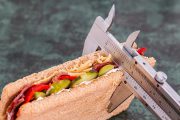Reading Labels & Tracking Macros – Eating for a Healthy Body
This post is the last in our recent nutrition series. We recommend reading the first, second and third and fourth installments first: How Important is Nutrition to Exercise and Your Health; Planning your Nutrition? Start Here; Macronutrient Calculations – Where to Begin and Calculating Macros for Weight Loss and Gain.
If you’ve been following our nutrition series, you should have a basic understanding of which apps can help with food tracking. I use My Fitness Pal and Live Strong because they’re free, but there are many paid-options you can use as well. Find something that works for you, because the next step is reading labels and using a food scale to bring us closer to our goal of constructing healthy eating plans.
Previous posts in this series have covered how to calculate daily calories and reviewed appropriate macronutrient percentages of proteins, carbohydrates and fats. Now that it’s time to track your macros, you should begin using measuring cups and a food scale to determine precise grams and hit your personal daily nutrition goals.
When building your meal plan, you should incorporate sensible choices like these:
- Protein: Eat lean cuts of meat, eggs, egg whites and supplement powders as needed to meet your protein goal
- Carbs: Eat oatmeal, brown and black rice, fruits and go heavy on the vegetables
- Fats: Look for high-quality fats rich in omega 3 and low in saturated content
This is a brief list, and you can look online to fill it out. Just run a search for each macro. And yes, you are allowed to be loose in some junk food – just be sure to count it into your daily macros.
One of the biggest tips I can offer is to start at home. Design your meal plan around food you’ll be preparing, and plan out the entire day. It’s nearly impossible to hit accurate counts if you’re making it up as you go. Low blood sugar can lead to bad judgment, so be wary of that.
Keep in mind as well that you should be drinking a lot of water too – shoot for half of your body weight in ounces daily. Alcohol will also need to be counted into your macros, as do all non-water beverages.
Tracking macros can seem difficult at first, but you’ll soon become proficient at recognizing portion sizes. If it sounds like a huge hassle, you may be right. But if you’re truly ready to make a lasting change to your nutrition and your physique, this is the right way to do it. Good luck, and I hope you’ve enjoyed the education.
If you’d like more personalized assistance, I’m happy to help. You can contact me directly to schedule a consultation.








Leave a Reply
Want to join the discussion?Feel free to contribute!